Camelia-M. Pintea
Selective Survey: Most Efficient Models and Solvers for Integrative Multimodal Transport
Mar 16, 2021Abstract:In the family of Intelligent Transportation Systems (ITS), Multimodal Transport Systems (MMTS) have placed themselves as a mainstream transportation mean of our time as a feasible integrative transportation process. The Global Economy progressed with the help of transportation. The volume of goods and distances covered have doubled in the last ten years, so there is a high demand of an optimized transportation, fast but with low costs, saving resources but also safe, with low or zero emissions. Thus, it is important to have an overview of existing research in this field, to know what was already done and what is to be studied next. The main objective is to explore a beneficent selection of the existing research, methods and information in the field of multimodal transportation research, to identify industry needs and gaps in research and provide context for future research. The selective survey covers multimodal transport design and optimization in terms of: cost, time, and network topology. The multimodal transport theoretical aspects, context and resources are also covering various aspects. The survey's selection includes nowadays best methods and solvers for Intelligent Transportation Systems (ITS). The gap between theory and real-world applications should be further solved in order to optimize the global multimodal transportation system.
A glass-box interactive machine learning approach for solving NP-hard problems with the human-in-the-loop
Aug 03, 2017
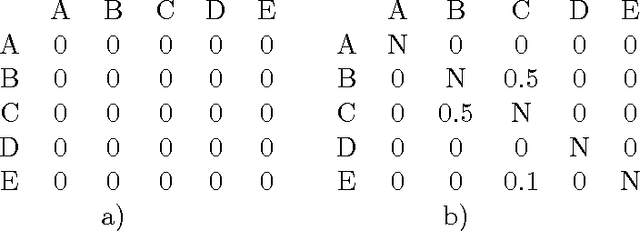
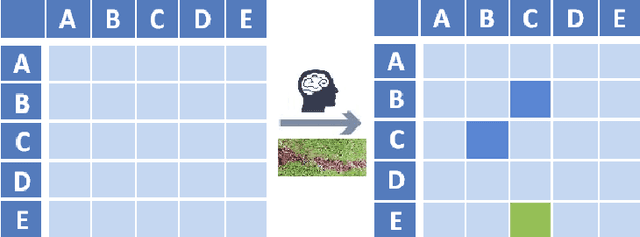
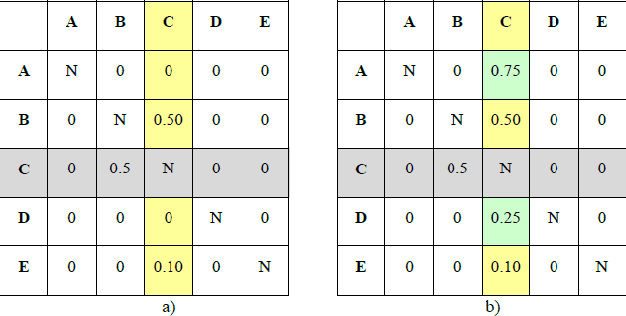
Abstract:The goal of Machine Learning to automatically learn from data, extract knowledge and to make decisions without any human intervention. Such automatic (aML) approaches show impressive success. Recent results even demonstrate intriguingly that deep learning applied for automatic classification of skin lesions is on par with the performance of dermatologists, yet outperforms the average. As human perception is inherently limited, such approaches can discover patterns, e.g. that two objects are similar, in arbitrarily high-dimensional spaces what no human is able to do. Humans can deal only with limited amounts of data, whilst big data is beneficial for aML; however, in health informatics, we are often confronted with a small number of data sets, where aML suffer of insufficient training samples and many problems are computationally hard. Here, interactive machine learning (iML) may be of help, where a human-in-the-loop contributes to reduce the complexity of NP-hard problems. A further motivation for iML is that standard black-box approaches lack transparency, hence do not foster trust and acceptance of ML among end-users. Rising legal and privacy aspects, e.g. with the new European General Data Protection Regulations, make black-box approaches difficult to use, because they often are not able to explain why a decision has been made. In this paper, we present some experiments to demonstrate the effectiveness of the human-in-the-loop approach, particularly in opening the black-box to a glass-box and thus enabling a human directly to interact with an learning algorithm. We selected the Ant Colony Optimization framework, and applied it on the Traveling Salesman Problem, which is a good example, due to its relevance for health informatics, e.g. for the study of protein folding. From studies of how humans extract so much from so little data, fundamental ML-research also may benefit.
On the Resilience of an Ant-based System in Fuzzy Environments. An Empirical Study
Feb 16, 2014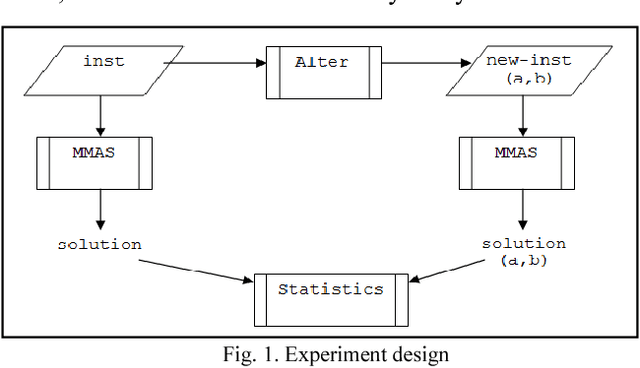
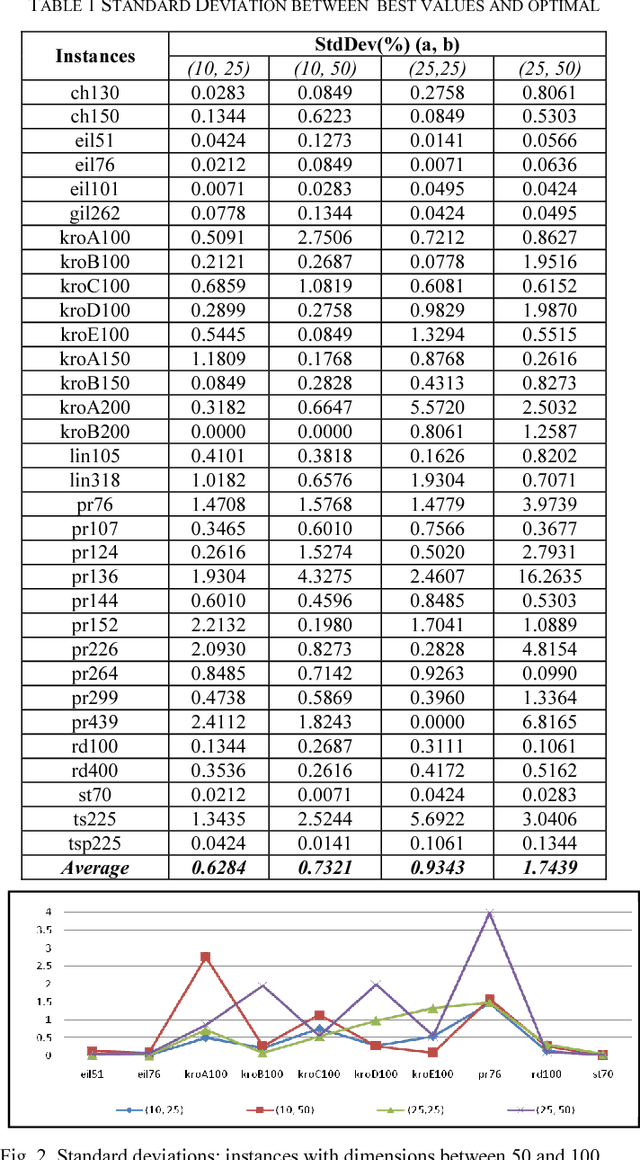
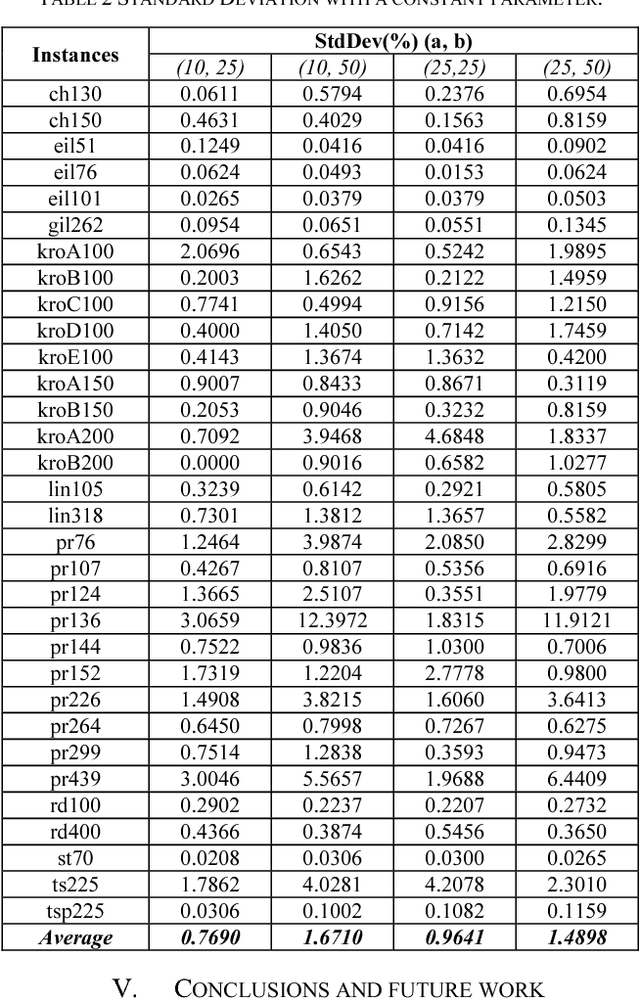
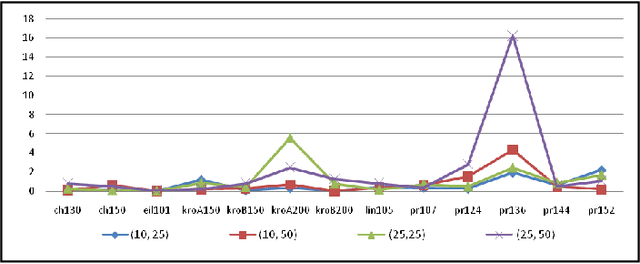
Abstract:The current work describes an empirical study conducted in order to investigate the behavior of an optimization method in a fuzzy environment. MAX-MIN Ant System, an efficient implementation of a heuristic method is used for solving an optimization problem derived from the Traveling Salesman Problem (TSP). Several publicly-available symmetric TSP instances and their fuzzy variants are tested in order to extract some general features. The entry data was adapted by introducing a two-dimensional systematic degree of fuzziness, proportional with the number of nodes, the dimension of the instance and also with the distances between nodes, the scale of the instance. The results show that our proposed method can handle the data uncertainty, showing good resilience and adaptability.
A Unifying Survey of Reinforced, Sensitive and Stigmergic Agent-Based Approaches for E-GTSP
Feb 13, 2014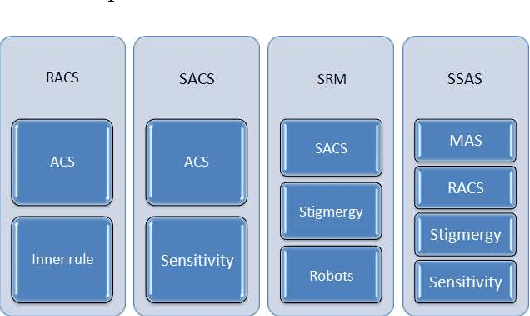
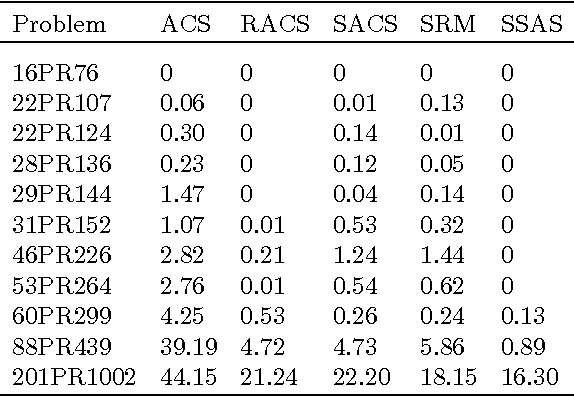
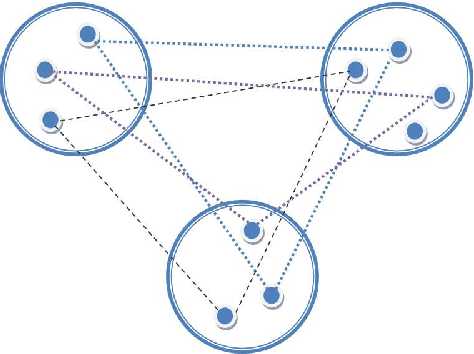

Abstract:The Generalized Traveling Salesman Problem (GTSP) is one of the NP-hard combinatorial optimization problems. A variant of GTSP is E-GTSP where E, meaning equality, has the constraint: exactly one node from a cluster of a graph partition is visited. The main objective of the E-GTSP is to find a minimum cost tour passing through exactly one node from each cluster of an undirected graph. Agent-based approaches involving are successfully used nowadays for solving real life complex problems. The aim of the current paper is to illustrate some variants of agent-based algorithms including ant-based models with specific properties for solving E-GTSP.
The Generalized Traveling Salesman Problem solved with Ant Algorithms
Oct 09, 2013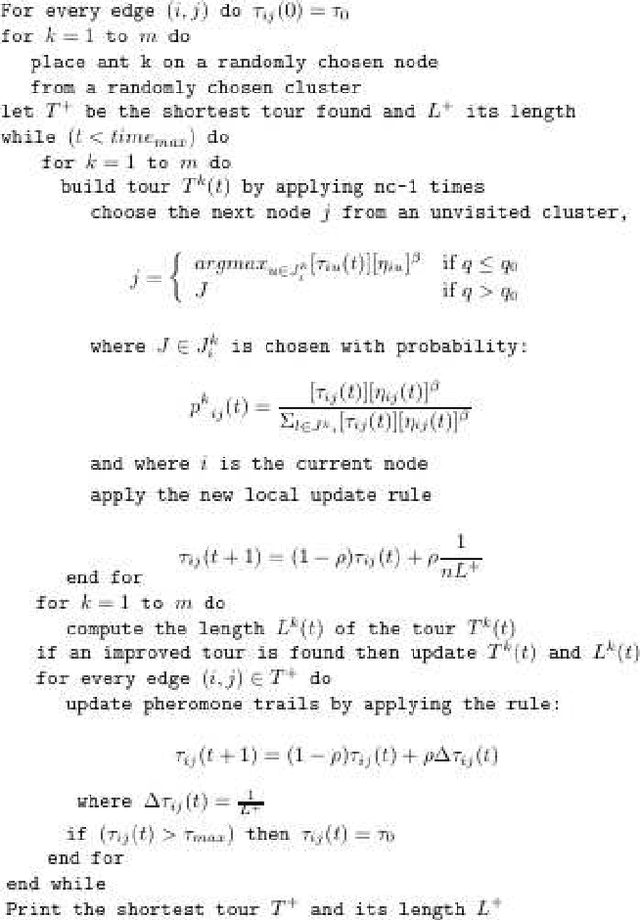
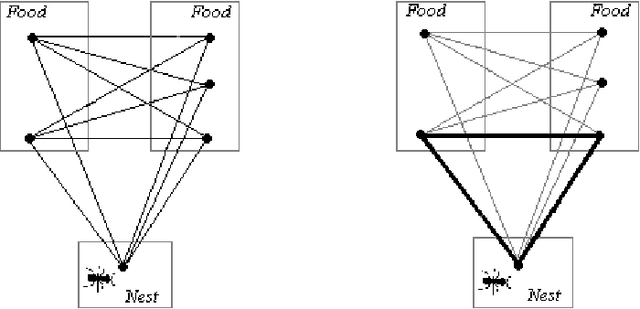
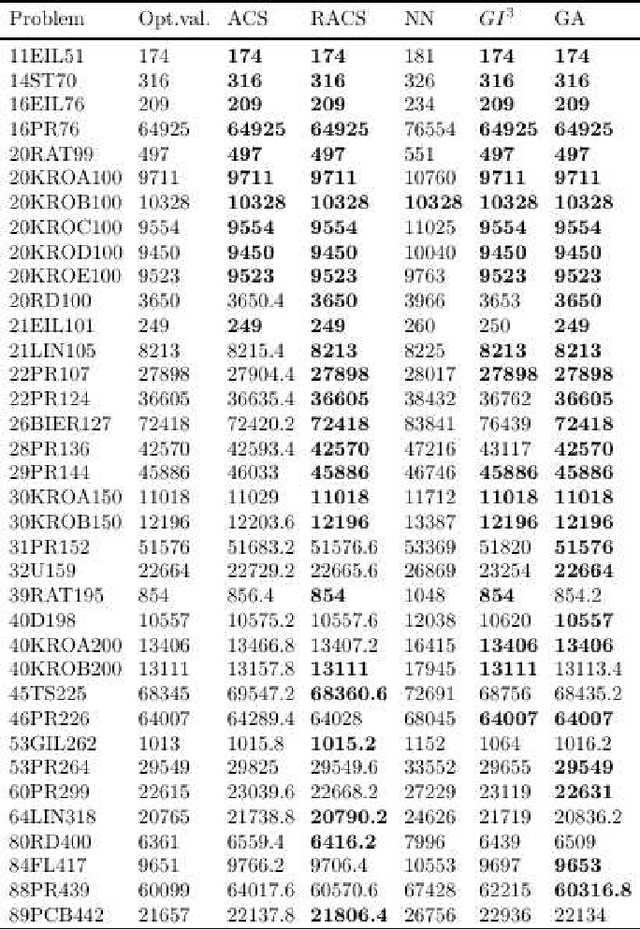
Abstract:A well known N P-hard problem called the Generalized Traveling Salesman Problem (GTSP) is considered. In GTSP the nodes of a complete undirected graph are partitioned into clusters. The objective is to find a minimum cost tour passing through exactly one node from each cluster. An exact exponential time algorithm and an effective meta-heuristic algorithm for the problem are presented. The meta-heuristic proposed is a modified Ant Colony System (ACS) algorithm called Reinforcing Ant Colony System (RACS) which introduces new correction rules in the ACS algorithm. Computational results are reported for many standard test problems. The proposed algorithm is competitive with the other already proposed heuristics for the GTSP in both solution quality and computational time.
* indexed in Scopus, ORCID
Parallel ACO with a Ring Neighborhood for Dynamic TSP
Oct 10, 2012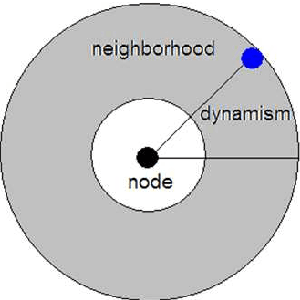
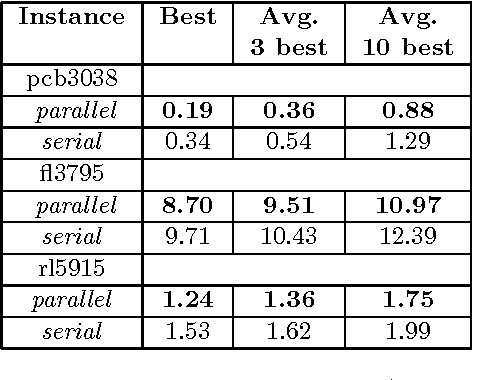
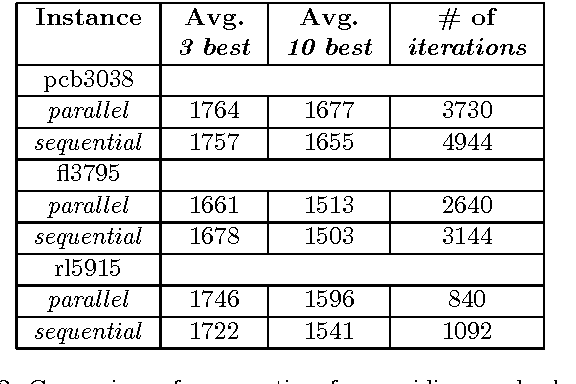
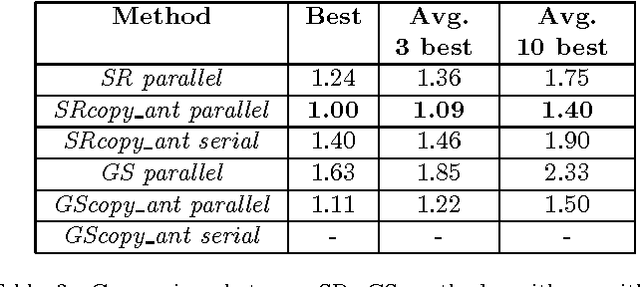
Abstract:The current paper introduces a new parallel computing technique based on ant colony optimization for a dynamic routing problem. In the dynamic traveling salesman problem the distances between cities as travel times are no longer fixed. The new technique uses a parallel model for a problem variant that allows a slight movement of nodes within their Neighborhoods. The algorithm is tested with success on several large data sets.
* 8 pages, 1 figure; accepted J. Information Technology Research
Comparing several heuristics for a packing problem
Oct 10, 2012
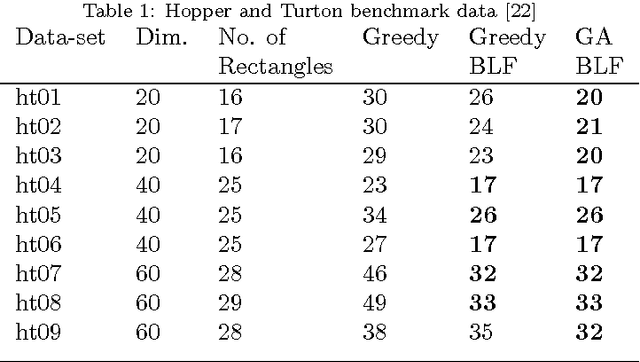

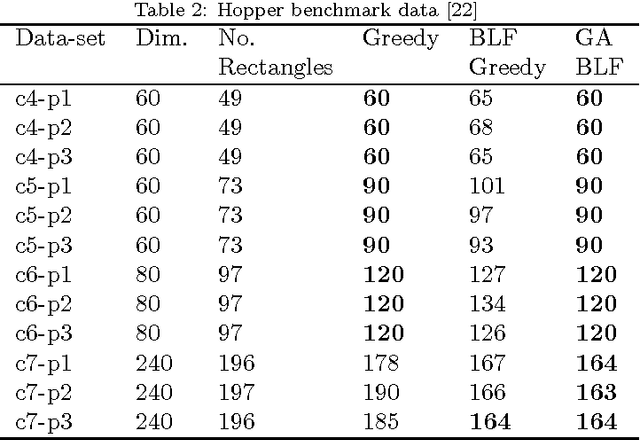
Abstract:Packing problems are in general NP-hard, even for simple cases. Since now there are no highly efficient algorithms available for solving packing problems. The two-dimensional bin packing problem is about packing all given rectangular items, into a minimum size rectangular bin, without overlapping. The restriction is that the items cannot be rotated. The current paper is comparing a greedy algorithm with a hybrid genetic algorithm in order to see which technique is better for the given problem. The algorithms are tested on different sizes data.
* 5 figures, 2 tables; accepted: International Journal of Advanced Intelligence Paradigms
A hybrid ACO approach to the Matrix Bandwidth Minimization Problem
Sep 16, 2012Abstract:The evolution of the human society raises more and more difficult endeavors. For some of the real-life problems, the computing time-restriction enhances their complexity. The Matrix Bandwidth Minimization Problem (MBMP) seeks for a simultaneous permutation of the rows and the columns of a square matrix in order to keep its nonzero entries close to the main diagonal. The MBMP is a highly investigated P-complete problem, as it has broad applications in industry, logistics, artificial intelligence or information recovery. This paper describes a new attempt to use the Ant Colony Optimization framework in tackling MBMP. The introduced model is based on the hybridization of the Ant Colony System technique with new local search mechanisms. Computational experiments confirm a good performance of the proposed algorithm for the considered set of MBMP instances.
* This paper has been withdrawn by the author, due to an error
Soft Computing approaches on the Bandwidth Problem
Aug 28, 2012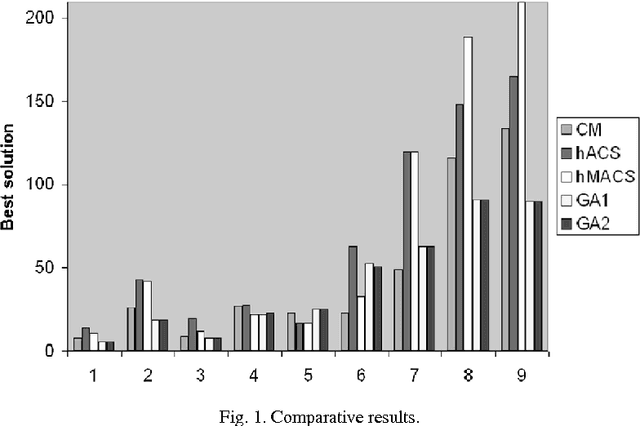
Abstract:The Matrix Bandwidth Minimization Problem (MBMP) seeks for a simultaneous reordering of the rows and the columns of a square matrix such that the nonzero entries are collected within a band of small width close to the main diagonal. The MBMP is a NP-complete problem, with applications in many scientific domains, linear systems, artificial intelligence, and real-life situations in industry, logistics, information recovery. The complex problems are hard to solve, that is why any attempt to improve their solutions is beneficent. Genetic algorithms and ant-based systems are Soft Computing methods used in this paper in order to solve some MBMP instances. Our approach is based on a learning agent-based model involving a local search procedure. The algorithm is compared with the classical Cuthill-McKee algorithm, and with a hybrid genetic algorithm, using several instances from Matrix Market collection. Computational experiments confirm a good performance of the proposed algorithms for the considered set of MBMP instances. On Soft Computing basis, we also propose a new theoretical Reinforcement Learning model for solving the MBMP problem.
* 6 pages, 1 figure; accepted to Informatica
Distributed Pharaoh System for Network Routing
Aug 27, 2012Abstract:In this paper it is introduced a biobjective ant algorithm for constructing low cost routing networks. The new algorithm is called the Distributed Pharaoh System (DPS). DPS is based on AntNet algorithm. The algorithm is using Pharaoh Ant System (PAS) with an extra-exploration phase and a 'no-entry' condition in order to improve the solutions for the Low Cost Network Routing problem. Additionally it is used a cost model for overlay network construction that includes network traffic demands. The Pharaoh ants (Monomorium pharaonis) includes negative pheromones with signals concentrated at decision points where trails fork. The negative pheromones may complement positive pheromone or could help ants to escape from an unnecessarily long route to food that is being reinforced by attractive signals. Numerical experiments were made for a random 10-node network. The average node degree of the network tested was 4.0. The results are encouraging. The algorithm converges to the shortest path while converging on a low cost overlay routing network topology.
* 4 pages, 4 figures
 Add to Chrome
Add to Chrome Add to Firefox
Add to Firefox Add to Edge
Add to Edge